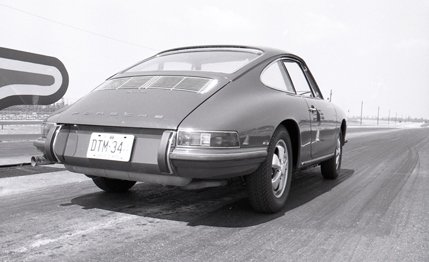The only real handling fault of the 911S is a corkscrewing motion of the front end when cornering on an undulating surface. This appears to be a by-product of the Porsche’s unconventional MacPherson strut front suspension. There is no loss of adhesion or directional stability, but with a lack of other vices it stood out disconcertingly.
If we’ve dwelled on the 911S’s handling traits, it’s because they are the most obvious departure from the standard 911, impressing us far more than the 32 extra horsepower. The 180-hp engine is notable mainly for its lack of temperament. Its idle is slightly more uneven, it accelerates with a more vigorous growl, prefers super-premium fuel, and consumes it a shade more prodigally than the 911. The power and torque curves aren’t “peaky,” and, except for an ill-advised change in gearing, it pulls as well from low revs. Revving it beyond its 7200 rpm redline would be all too easy were it not for a centrifugal ignition governor concealed in the distributor arm.
|
|
With racing versions of Porsche’s flat-six pulling close to 235 horsepower, raising the output of the street engine to 180 horsepower was easy—a matter of subtle changes in the cam timing and carburetor jetting (Webers are used on all 6-cylinder Porsches now), plus an increase in compression ratio from 9.0- to 9.8-to-one. Initial reports indicate that there is less carbon build-up with the higher compression ratio. Oil control appears to be difficult even on the 148-hp engine, however, with most owners reporting 400–500 miles per quart. The dry sump holds nearly two gallons, so topping up could be a matter of every other gas stop.
The original 911 had a long, 2.83 first gear, which made the car hard to start from rest. To ease the load on the clutch, first gear on all Porsches has been shortened to 3.09, with the other gears closed up in suit. The 911 and 912 have .86 high gears while the 911S has a .79 high gear, enabling its engine to wind the car out to its full top-speed potential of 140 mph. Unfortunately, this has resulted in a wider gap between fourth and fifth gears, and a 20%, loss of pulling power in high. A gearchange is necessary for surprisingly mild hills. Since nobody in his right mind should think the unthinkable—140 mph on our public highways-a shorter fifth gear would mean less rowing back-and-forth on the gearshift lever. We really didn’t mind more frequent use of the transmission, though; slicing through the Porsche’s gears remains one of the great delights of the Western Hemisphere.
Little else is changed from the 911 of our April, 1965 Road Research Report. The styling still looks good to us, and, like any Porsche, it has personality in its design, workmanship, and its seat-of-the-pants telegraphy about what it’s doing. The firmer ride heightens this sensation, although thankfully, the increase in stiffness has not been accompanied by a similar increase in harshness. Sidewind sensitivity, already a tender subject with 911 owners, is, if anything, slightly worse in the 911S, although hardly noticeable below a thoroughly illegal 120 mph.
|
|
Maybe it’s just us, but, in retrospect, the steering wheel seems oversized, giving more leverage than needed on one of the easiest-steering cars built today. Also, we note that an optional spacer can bring the wheel 1-1/2 inches closer to the driver, which we think we’d prefer. Otherwise, the interior is a model for the way all cars should be built-sports cars or utility sedans, front-engined or rear, Detroit or Kharkov. The seats, upholstered in a new air-flow weaving, stay cooler, and, as always, are almost infinitely adjustable to a variety of comfortable positions. There’s plenty of room (except, perhaps, elbow room), and all the controls are located where you can get at them easily and operate them efficiently.
Just cruising around town or belting along back roads like a would-be racer, the 911S is a great way for getting from Point A to Point B, even when Point B represented only an excuse to drive somewhere.
Each successive Porsche has been the ultimate Porsche, which is akin to its being the ultimate luxury GT car. The 911S surely must be the all-time high. Where can Porsche go from here? Build a car with disappearing headlights?
View Photos
View Photos


Leave a Reply